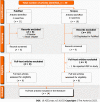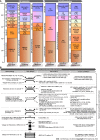Current overview of induced pluripotent stem cell-based blood-brain barrier-on-a-chip
- PMID: 37424947
- PMCID: PMC10324508
- DOI: 10.4252/wjsc.v15.i6.632
Current overview of induced pluripotent stem cell-based blood-brain barrier-on-a-chip
Abstract
Background: Induced pluripotent stem cells (iPSCs) show great ability to differentiate into any tissue, making them attractive candidates for pathophysiological investigations. The rise of organ-on-a-chip technology in the past century has introduced a novel way to make in vitro cell cultures that more closely resemble their in vivo environments, both structural and functionally. The literature still lacks consensus on the best conditions to mimic the blood-brain barrier (BBB) for drug screening and other personalized therapies. The development of models based on BBB-on-a-chip using iPSCs is promising and is a potential alternative to the use of animals in research.
Aim: To analyze the literature for BBB models on-a-chip involving iPSCs, describe the microdevices, the BBB in vitro construction, and applications.
Methods: We searched for original articles indexed in PubMed and Scopus that used iPSCs to mimic the BBB and its microenvironment in microfluidic devices. Thirty articles were identified, wherein only 14 articles were finally selected according to the inclusion and exclusion criteria. Data compiled from the selected articles were organized into four topics: (1) Microfluidic devices design and fabrication; (2) characteristics of the iPSCs used in the BBB model and their differentiation conditions; (3) BBB-on-a-chip reconstruction process; and (4) applications of BBB microfluidic three-dimensional models using iPSCs.
Results: This study showed that BBB models with iPSCs in microdevices are quite novel in scientific research. Important technological advances in this area regarding the use of commercial BBB-on-a-chip were identified in the most recent articles by different research groups. Conventional polydimethylsiloxane was the most used material to fabricate in-house chips (57%), whereas few studies (14.3%) adopted polymethylmethacrylate. Half the models were constructed using a porous membrane made of diverse materials to separate the channels. iPSC sources were divergent among the studies, but the main line used was IMR90-C4 from human fetal lung fibroblast (41.2%). The cells were differentiated through diverse and complex processes either to endothelial or neural cells, wherein only one study promoted differentiation inside the chip. The construction process of the BBB-on-a-chip involved previous coating mostly with fibronectin/collagen IV (39.3%), followed by cell seeding in single cultures (36%) or co-cultures (64%) under controlled conditions, aimed at developing an in vitro BBB that mimics the human BBB for future applications.
Conclusion: This review evidenced technological advances in the construction of BBB models using iPSCs. Nonetheless, a definitive BBB-on-a-chip has not yet been achieved, hindering the applicability of the models.
Keywords: Blood-brain barrier; Cell differentiation; Induced pluripotent stem cells; Microfluidic device; Neurovascular unit; Organ-on-a-chip.
©The Author(s) 2023. Published by Baishideng Publishing Group Inc. All rights reserved.
Conflict of interest statement
Conflict-of-interest statement: The authors have no conflicts of interest to declare.
Figures


Similar articles
-
Microfluidic blood-brain barrier model provides in vivo-like barrier properties for drug permeability screening.Biotechnol Bioeng. 2017 Jan;114(1):184-194. doi: 10.1002/bit.26045. Epub 2016 Jul 21. Biotechnol Bioeng. 2017. PMID: 27399645 Free PMC article.
-
Generation of a Human iPSC-Based Blood-Brain Barrier Chip.J Vis Exp. 2020 Mar 2;(157). doi: 10.3791/60925. J Vis Exp. 2020. PMID: 32176199
-
Recent advances in blood-brain barrier-on-a-chip models.Acta Biomater. 2025 May 1;197:1-28. doi: 10.1016/j.actbio.2025.03.041. Epub 2025 Mar 22. Acta Biomater. 2025. PMID: 40127880 Review.
-
Human iPSC-Derived Blood-Brain Barrier Chips Enable Disease Modeling and Personalized Medicine Applications.Cell Stem Cell. 2019 Jun 6;24(6):995-1005.e6. doi: 10.1016/j.stem.2019.05.011. Cell Stem Cell. 2019. PMID: 31173718
-
Getting closer to modeling the gut-brain axis using induced pluripotent stem cells.Front Cell Dev Biol. 2023 Mar 31;11:1146062. doi: 10.3389/fcell.2023.1146062. eCollection 2023. Front Cell Dev Biol. 2023. PMID: 37065853 Free PMC article. Review.
Cited by
-
Isolation methods and characterization of primary rat neurovascular cells.J Biol Eng. 2024 Jul 11;18(1):39. doi: 10.1186/s13036-024-00434-3. J Biol Eng. 2024. PMID: 38992711 Free PMC article.
-
In vitro technology and ADMET research in traditional Chinese medicine.Front Pharmacol. 2025 Jul 9;16:1605330. doi: 10.3389/fphar.2025.1605330. eCollection 2025. Front Pharmacol. 2025. PMID: 40703346 Free PMC article. Review.
-
The Multifaceted Role of L-Type Amino Acid Transporter 1 at the Blood-Brain Barrier: Structural Implications and Therapeutic Potential.Mol Neurobiol. 2025 Mar;62(3):3813-3832. doi: 10.1007/s12035-024-04506-9. Epub 2024 Sep 26. Mol Neurobiol. 2025. PMID: 39325101 Review.
-
Emergent trends in organ-on-a-chip applications for investigating metastasis within tumor microenvironment: A comprehensive bibliometric analysis.Heliyon. 2023 Dec 9;10(1):e23504. doi: 10.1016/j.heliyon.2023.e23504. eCollection 2024 Jan 15. Heliyon. 2023. PMID: 38187238 Free PMC article.
-
Contribution of CNS and extra-CNS infections to neurodegeneration: a narrative review.J Neuroinflammation. 2024 Jun 6;21(1):152. doi: 10.1186/s12974-024-03139-y. J Neuroinflammation. 2024. PMID: 38845026 Free PMC article. Review.
References
-
- Wiegand C, Banerjee I. Recent advances in the applications of iPSC technology. Curr Opin Biotechnol. 2019;60:250–258. - PubMed
-
- Ray A, Joshi JM, Sundaravadivelu PK, Raina K, Lenka N, Kaveeshwar V, Thummer RP. An Overview on Promising Somatic Cell Sources Utilized for the Efficient Generation of Induced Pluripotent Stem Cells. Stem Cell Rev Rep. 2021;17:1954–1974. - PubMed
-
- Sundaravadivelu PK, Raina K, Thool M, Ray A, Joshi JM, Kaveeshwar V, Sudhagar S, Lenka N, Thummer RP. Tissue-Restricted Stem Cells as Starting Cell Source for Efficient Generation of Pluripotent Stem Cells: An Overview. Adv Exp Med Biol. 2022;1376:151–180. - PubMed
LinkOut - more resources
Full Text Sources
Miscellaneous

